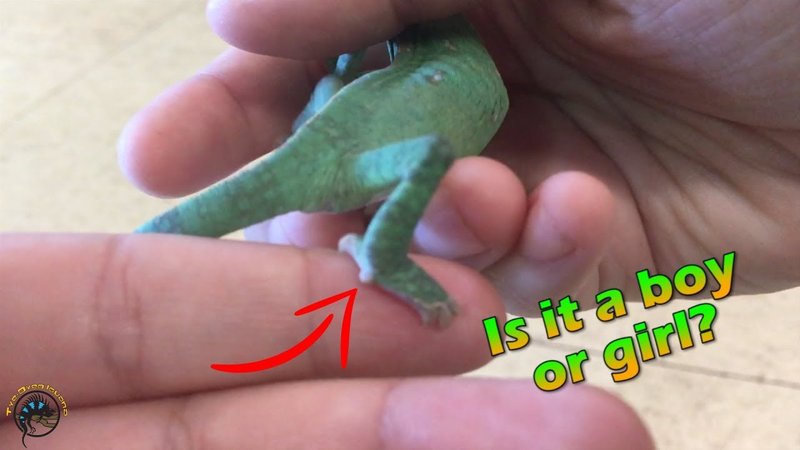
Physical Differences Between Male and Female Jackson’s Chameleons
When it comes to telling the gender of a Jackson’s chameleon, the physical characteristics are your primary clues. Males and females differ in size, color, and even body shape.
Size Matters
One of the most notable differences is size. Male Jackson’s chameleons tend to be larger than females. Typically, males can reach lengths of about 10 to 12 inches, while females usually cap out around 6 to 8 inches. This size disparity may seem subtle, but it’s one of the easiest ways to spot the differences, especially when they’re both fully grown.
Color Variations
Color is another big indicator. Male chameleons often display vibrant, eye-catching colors. They can turn bright greens, blues, and yellows, especially during mating season or when they’re excited. Females, on the other hand, tend to have more muted colors, which can range from browns to soft greens. This doesn’t mean females can’t be beautiful—they just express it differently than their male counterparts.
Body Shape
The body shape also plays a role. Male Jackson’s chameleons have a more robust build with pronounced, sometimes spiky, dorsal crests. This can give them a somewhat bulkier appearance. In contrast, females generally have a sleeker, more streamlined body that is designed to carry eggs when they’re ready to breed. This subtle variation might require a sharper eye, but it’s worth noting.
Behavioral Indicators
Aside from physical traits, the behavior of a Jackson’s chameleon can also help you determine its gender. Observing how they act can reveal a lot.
Mating Displays
During mating season, males are known to exhibit some unique behaviors to attract females. They might display more vibrant colors, puff themselves up, and show off by bobbing their heads. It’s almost like a reptilian dance! If you observe your chameleon doing these things, you’re likely looking at a male.
Territoriality
Males are generally more territorial than females. If you have two males in the same space, you’ll probably notice them puffing up and trying to assert dominance. Females don’t usually display this behavior as intensely unless they’re feeling threatened. If your chameleon seems friendly and less aggressive, it might be a female.
Egg-Laying Behavior
Only female Jackson’s chameleons can lay eggs, which is a clear giveaway. If your chameleon is digging in the substrate or seems restless around breeding season, there’s a chance it could be female. Keep an eye out for these signs, especially if you’re hoping to breed.
Checking for Hemipenes
If you want a foolproof method, a close inspection can help. Male Jackson’s chameleons have a pair of hemipenes tucked inside their bodies. These are reproductive organs that look like small fleshy structures.
The Inspection Process
To safely check for hemipenes, you can gently turn the chameleon upside down. Keep it calm and ensure you’re not stressing it out. As you look, if you see a slight bulge or two at the base of the tail, you’re likely looking at a male.
Know When to Seek Help
Though checking for hemipenes can be effective, it’s not always straightforward. If you’re unsure, it’s perfectly fine to take your chameleon to a vet familiar with reptiles. They can help you determine the gender without causing stress.
Color Changes Throughout Life
Another aspect to consider is that the colors and characteristics of Jackson’s chameleons can change over time. Young chameleons usually don’t display the same bright, vivid colors as adults. This can make gender identification tricky if you’re looking at a juvenile.
Juvenile Differences
Young males tend to exhibit colors that are less vibrant than those seen in adult males but might show hints of their future brightness. Females will also show some color, but it will remain muted. Over time, as they mature, these differences become more distinct.
Waiting It Out
If you’re unsure about the gender of a juvenile Jackson’s chameleon, it might be best to wait until they reach maturity. During this time, you’ll start to see more pronounced differences, helping you identify their gender more accurately.
Why Gender Matters for Care
Understanding the gender of your Jackson’s chameleon goes beyond mere curiosity. It can impact how you care for them and what kind of environment you set up.
Behavioral Expectations
Knowing whether your chameleon is male or female can help you set expectations for their behavior. Males may require more space due to their territorial nature, while females might prefer a quieter environment, especially when preparing to lay eggs.
Breeding Considerations
If you plan on breeding, knowing the gender is crucial. Males and females need to be introduced properly to minimize stress and aggression. Understanding their behaviors also helps create a balanced environment during the breeding process.
Health and Diet
The dietary needs slightly differ based on gender as well. Female chameleons might require additional calcium and nutrients to support egg production. Understanding gender helps ensure you provide the right care and dietary needs for your pet’s specific situation.
Telling the gender of a Jackson’s chameleon can feel like deciphering a puzzle at first, but once you familiarize yourself with their unique traits, it becomes much clearer. Focus on size, color, behavioral aspects, and close examinations to determine if your chameleon is a male or female. Ultimately, knowing the gender can lead to better care, ensuring a happier home for your new reptilian friend. Enjoy the journey of getting to know your chameleon—these colorful creatures have so much to offer!

